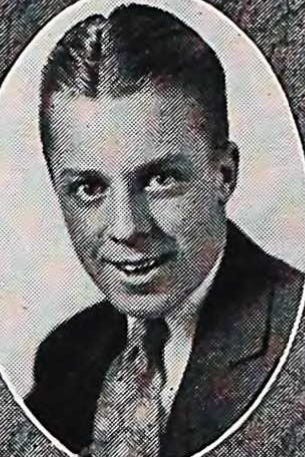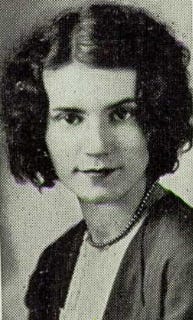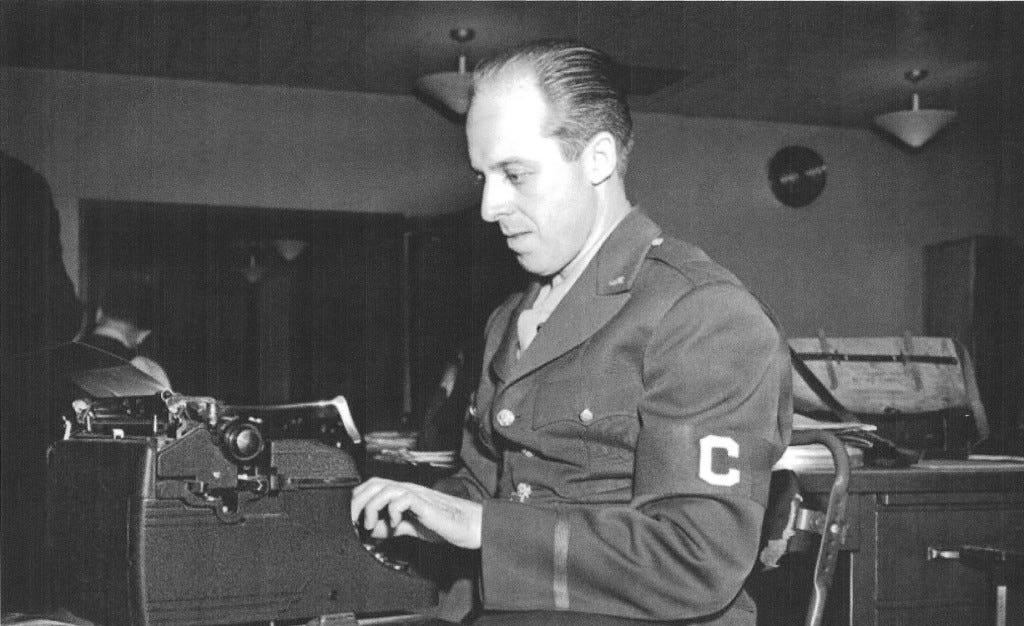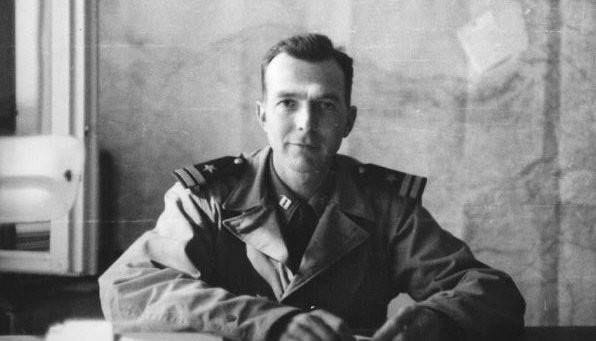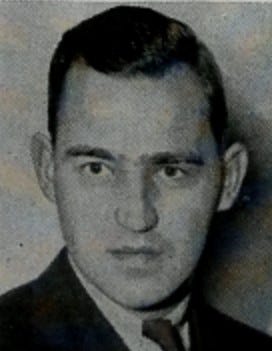Joe Morton: War correspondent executed by the Nazis
Dozens of journalists died covering World War II, some of them victims of stray bullets or shrapnel on the battlefield, others aboard planes or ships that went down in combat. We have told many of their stories here.
Of all those who gave their lives in pursuit of the news, though, only one was deliberately targeted for death: Associated Press correspondent Joe Morton, who was executed Jan. 24, 1945 at the Mauthausen concentration camp in Austria. This is his story.
Joseph Morton was born June 30, 1911, near St. Joseph, Missouri. His father, also named Joseph, was an accomplished local attorney who had married Joe's mother, Pearl, in 1909 after the death of his first wife. When the elder Morton died in 1938, an editorial in the St. Joseph News-Press compared him at length to John Quincy Adams.
Joe caught the journalism bug early. Census records from 1930 list the occupation of the teenager, still living at home, as a newspaper reporter. Morton was doing some work for the News-Press at the time, but his name appeared in the local papers mostly for his tennis exploits: he won the city high school singles championship in 1929 and continued to play in area tournaments for the next few years.
Morton's friends called him "Budge," a nickname that also appeared in the newspaper from time to time. After graduating from Central High School, Morton attended a variety of schools, including St. Joseph Junior College, St. Benedict's College in Kansas, the University of Nebraska and Iowa State College. In 1935, he went to work for the Des Moines Register and Tribune, where he often wrote about agricultural issues.
That summer, he married a hometown girl, Letty Miller. They had attended high school and junior college together, and she was enrolled at the University of Chicago after previously studying at the University of Missouri.
Morton also had a stint at the Omaha Bee-News before joining the Associated Press in 1937 in Lincoln, Nebraska. He transferred to the AP bureau in Cleveland and then on to New York as an editor in 1940.
He officially became a war correspondent in May 1942, as recounted in a dramatic scene the News-Press ran on the front page of its June 2 editions:
(Morton) liked excitement and adventure and must have enjoyed the way in which he left the New York office of the Associated Press.
An army man entered the office, took Joe aside and whispered departure instructions. Joe couldn't even tell his boss. He took a train down the Southern seaboard and was to get off at a small town to be met by an army captain. If the train reached the rendezvous many hours before the meeting time, Joe was not to wear his uniform, as the army wanted no one in uniform walking around to arouse curiosity.
Mrs. Morton later received a dozen American Beauty roses from Joe, which meant that he was leaving the states. It is believed he is headed for the tropics and some place where there has been no action thus far. However, soldiers were going too and there probably will be plenty of action soon.
That undisclosed location turned out to be Africa, though it would be months before Morton's initial dispatches made it into print. The correspondent accompanied U.S. troops into Liberia that summer, but his first report on U-boat activity off the African coast -- datelined "A United Nations Base in West Africa" -- didn't hit the wires until Oct. 10.
In early December, newspapers ran Morton's account of Pfc. Napoleon Edward Taylor of Baltimore, a Black soldier who became the first member of the "American expeditionary force ever to set foot in Africa" when his detachment landed in Liberia long before Operation Torch. The scene Morton described had occurred June 17, but was not released by censors for more than five months because the presence of U.S. troops in Liberia had not been officially disclosed.
Late in 1942, Morton accompanied American forces into Dakar two years after the failed British and Free French attempt to take the port. At the end of January 1943, he was the lone correspondent aboard the French battleship Richelieu as she sailed from Dakar to New York for a refitting at the Brooklyn Navy Yard.
These and future assignments had something in common: Morton was covering them on his own, in a mostly overlooked theater of operations. There was no press camp, no colleague/competitor accompanying him to the front in a shared jeep.
He had no trouble working independently, which could not necessarily be said for many of his peers. That inclination led to numerous stories no one else had, but also played a role in his ultimate demise.
Morton made a brief visit home after his voyage with the Richelieu but returned to Africa soon after. In July 1943 he rode in a B-26 for the first bombing raid on Rome, accompanying two veterans of the Doolittle raid on the sortie.
He continued covering the air war from Sicily but eventually contracted malaria and was ordered back to the U.S. in the fall. It would be his final time seeing his wife and family.
Back in Europe in 1944, Morton returned to his usual pursuits. In April, he sent Yugoslav partisan leader Josip Broz -- better known as Marshal Tito -- a series of written questions about the situation in the region, which Allied correspondents had been barred from traveling to since the previous fall.
Tito responded in his own hand, and Morton composed a 1,600-word story around those answers and submitted it to Allied censors in Algiers on April 30. But censors refused to clear the story and refused to say why, sparking a controversy that played out in newspapers worldwide when the AP took its protests about the matter public in mid-May.
The situation escalated when Allied officials chose two reporters by lot in Cairo, John Talbot of Reuters and Stoyan Pribichevich of Time and Life, and facilitated in-person interviews at Tito's headquarters on May 10. While those stories ran in newspapers days later, Morton's remained on hold until it finally was released for publication on May 20.
The one bit of good news during the frustrating wait for clearance came from home. On Aug. 3, Morton's wife Letty gave birth to the couple's first child, daughter Melinda Ann. The announcement made the front page of the St. Joseph Gazette.
Morton continued to report on the war throughout the summer from his base at 15th Air Force headquarters in Bari, Italy, before turning his focus to the Balkans. He was in Bucharest when Russian troops rolled into the capital on Aug. 31, the first foreign correspondent on the scene.
Days later he secured an exclusive interview with the nation's leader, 22-year-old King Mihai (or Michael I), who described the coup that had led to the ouster of the Nazi-backed regime in Romania ahead of the Russians' arrival. That story was a global sensation, later described in an internal AP newsletter as Morton's "outstanding beat," his signature scoop.
Around the same time, the Allies had intensified their efforts to evacuate airmen who had gone down behind enemy lines in the Balkans. They sent in teams from the U.S. Office of Strategic Services (OSS) and British Special Operations Executive (SOE) to connect with partisans who were helping the downed fliers evade German capture.
On Sept. 17, Navy Lt. James Holt Green, who went by his middle name, led a small detachment of OSS operatives code-named "Dawes" into Banská Bystrica. Located about 115 miles north of Budapest, the city was the base of power for the Slovak National Uprising, the partisan movement that had recently gained traction against the Nazi-controlled government. Though the mission officially was focused on rescuing the aircrews, Green's true focus was on supporting the popular uprising. A small SOE team led by Maj. John Sehmer soon parachuted in to join them in the effort, though Green had not been informed about those plans in advance.
But the partisans' momentum stalled and the Germans pushed back, leading Green to cable back to headquarters that the situation was becoming "critical." Though he also asked that no more men be sent in, only supplies and planes to evacuate more airmen, Allied officials readied another team to fly out from Bari in support of what became known as the Dawes mission.
Morton had accompanied similar evacuation flights before and convinced officials in Bari that the rescue of Allied airmen from behind enemy lines would be a worthwhile story. They acquiesced, and Morton dashed off a quick message to the AP on Oct. 7 saying only that he was off to cover the greatest story of his life.
Morton was aboard one of six B-17s that landed at the Tri Duby airfield (now known as Sliač) south of Banská Bystrica that day. He and 13 other new arrivals stayed with the local team while two dozen airmen returned to Italy on the bombers. OSS Maj. Walter Ross made the round trip, bringing back to Bari the final dispatch sent by Joe Morton. But that story never saw the light of day, as it was initially held by censors in Italy for security reasons before disappearing.
Green's team continued its work with the Slovak partisans and awaited more evacuation planes, but they never came. Though Russian aircraft made regular flights into the area, they declined to take Western aircrew out alongside their own evacuees.
Soon, the situation became untenable, and German forces recaptured the airfield Oct. 26. The OSS and SOE teams had departed the previous day and were now on the run along with the partisans and some of the downed airmen. They eventually made their way east, into the mountains, and ended up near Polomka in mid-December.
It was a brutal journey with winter setting in and no easy way to attain food along the way. A 2002 book by Jim Downs, World War II: OSS Tragedy in Slovakia, describes the odyssey at length. The story leans heavily on the recollections of Maria Gulovich, a local teacher who accompanied much of the mission as a translator. She seems to have bonded with Morton and the pair did everything they could to help one another.
By mid-November, Morton was one of several members of the party who was unable to put his boots on because his feet were so swollen. The correspondent began wearing sabots -- wooden shoes that allowed for a bit more room due to their open backs but also were totally unsuited for the party's mountain trekking.
"Although in misery," Downs wrote, " Morton never allowed the ordeal to dampen his spirits."
The group's numbers also dwindled as some were captured along the way, mostly while on patrols seeking food. But the rest kept on, desperately evading German and fascist Slovak pursuers who knew they were on the run.
After more than a month without any kind of contact with headquarters, the group managed to get a garbled message through to Bari in mid-December. It summarized their situation and provided their location, but no rescue was forthcoming.
The group tried to inject some semblance of festive spirit as Christmas approached, decorating the hut in which they were hiding and procuring food for a proper holiday dinner. Gulovich sat next to Morton at the meal, and would later recall that the correspondent "had a faraway look in his eyes. His baby daughter had been born while he was overseas, and I imagined he was thinking of her. Nobody said anything. Their thoughts were all elsewhere."
On Christmas afternoon, Gulovich departed along with two Americans and two Brits for Vel'ky Bok, a mountaintop ski lodge where Slovak partisans were hiding out. Morton accompanied the group up the trail for a half-mile before bidding them farewell and turning around to return to the hut.
Around 8:30 the following morning, a German unit led by Maj. Erwein Thun-Hohenstein that had been hunting the fugitives arrived at the hut. Vastly outnumbered, the Allies had no choice but to surrender. The raiding party discovered documents, maps, a camera, a typewriter, a short-wave radio and other items in the hut that would eventually be used as evidence that these were not ordinary soldiers, but spies.
Morton and the other prisoners were marched down to the town of Polomka and loaded into trucks for transfer to Brezno and eventually back to a jail in Banská Bystrica. A few days later they were sent to Bratislava and then finally west to Mauthausen, the large concentration camp near Linz, Austria, where they arrived Jan. 7, 1945.
Over several days in January, the prisoners were interrogated and many were tortured by SS and Gestapo officials and the camp's commandant, Franz Ziereis. Morton repeatedly told his captors he was a civilian, producing his war correspondent identification.
On Jan. 24 the head of the Reich Main Security Office (RSHA), Ernst Kaltenbrunner, sent a telegram to Ziereis directing that the prisoners be shot immediately. Camp officials informed the men that they were being transferred and told them they needed to be photographed and change into prison clothes as part of the procedure. Instead, they were led into the basement one by one, ordered to remove their clothes, and shot in the back of the head.
Citing witnesses at the camp, Downs' book suggests only about half of the Anglo-American party was executed on the 24th, including Green and Sehmer, with the rest likely shot on Feb. 9. The timeline on Morton's fate isn't clear, but Jan. 24 is generally listed as his date of death.

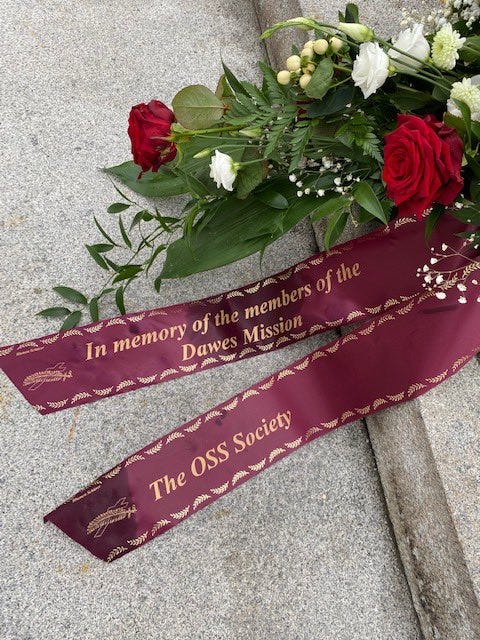
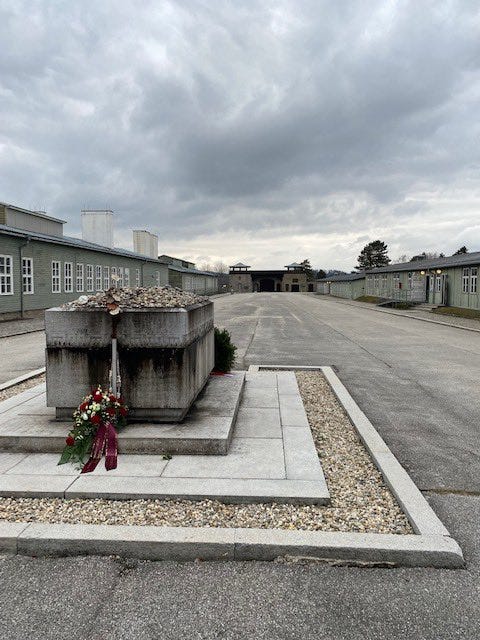
That same day, German news agencies Transocean and DNB reported the execution of 18 British and American "agents" who purportedly were captured in Slovakia after engaging in sabotage and espionage. The reports said an American named Green and an Englishman named Sehmer were the leaders of the group and claimed the men were in civilian clothing rather than uniforms.
OSS officers in Bari heard the news an immediately assumed the worst about the Dawes team, which had been out of touch for most of the last three months.
Western wire services AP, UP and INS all moved stories on the reports, some of which appeared in evening newspapers in the U.S. the same day. In Missouri, Letty Miller Morton saw the story and had a bad feeling about it. She contacted AP headquarters in New York the following day asking what they knew about Joe's whereabouts but didn't come away with any firm answer.
None would be forthcoming for quite a while, though the AP continued to work desperately via its global contacts to find Morton. Finally, in early March, Walter Ross got word of a British SOE officer named Stefan Zenopian who had witnessed the Dec. 26 capture of Morton and the others at the hut near Polomka and had since escaped German captivity. Ross got the full story from Zenopian and Allied officials informed the AP of the news.
AP correspondent Noland "Boots" Norgaard filed a story from Rome on March 4 citing a "British officer" saying Morton and others had been captured. The report made a point of noting that the prisoners were wearing uniforms and he was "absolutely certain" Morton was among them. The AP passed the information along to Letty on March 5 and the story hit the wires for publication in March 6 editions.
While that report surely provided a glimmer of hope, there was no word of Morton being located in a POW camp or any other positive signs. In the meantime, Walter Ross wrote Letty Miller Morton a letter describing his last interactions with her husband and holding out hope that he would be found alive.
"The last I saw of him he was working away at his typewriter under the wing of a plane and to me it seemed a perfectly natural place for him, as I had seen him so many times in Romania," Ross wrote.
As the war in Europe wound down that spring, the AP pressed military officials to allow its staff to conduct an investigation, and after Germany surrendered in early May the OSS sent an agent and an investigator out with AP correspondent Lynn Heinzerling to track the story.
They wound up interviewing multiple people who had been present at Mauthausen, including a German interpreter who had assisted with the interrogations and a former prisoner who had been assigned to remove bodies from the death chamber.
By early July, Heinzerling was convinced of Morton's fate. He filed a story July 7 with a Linz dateline citing German officials confirming Morton's capture and execution. Before it was cleared to run in newspapers, the AP informed Letty of its conclusion.
The St. Joseph News-Press found out about the news in time to run a story on the front page of its July 8 editions, printing the news a day before it actually hit the wire for other newspapers to publish.
Heinzerling's lengthy account of the saga, which ran in most newspapers' July 9 editions, recounted the party's trek across Czechoslovakia and included details of the torture inflicted on the prisoners.
Shortly after receiving the news she had anticipated but dreaded nonetheless, Letty wrote to AP chief Kent Cooper. He replied the same day with a telegraph asking if she would mind if he printed her letter in the company's internal newsletter, the AP World, and she agreed. It read in part:
This tragic news still is too recent for me to express my feelings in an orderly fashion. However, I do want to tell you how I look upon Joe's death. It goes without saying that his passing is an irreparable loss to me and yet I do find comfort in the fact that he was doing the work he loved. ...
I am torn with grief over the horrors of January. Joe must have been subject to the hardships just as the others were -- why would the Nazis exempt him during the questioning when they did not do so at the final moment. January, a procession of sleepless nights and depressing days, was the most difficult month of the long winter of silence. My mind was tortured with pictures of Joe in grave distress. Toward the end of that month the feeling engulfed me that I never, in this world, would see Joe again. ...
I am proud that Joe contributed to the history of The Associated Press. He still had many years of brilliant reporting before him. I do not profess to understand why he had to be taken from us. My heart will always ask and always long for him.
After the war, Letty lived in New York for a time, working in public relations, before returning to St. Joseph to raise her daughter, who everyone called Mimi.
In September 1948, Letty went to work at the newspaper where her late husband's career began, the News-Press. She became an editorial writer, which in itself was quite an accomplishment at the time. Her longtime colleague Mary Helen Burrowes would write in 1983 that, to her knowledge, Letty was "the only woman assigned entirely to editorial writing the News-Press has ever had."
Mimi eventually married and moved to Kentucky, and Letty visited her daughter and grandchildren whenever she could.
Letty Miller Morgan died in November 1983, a day before her 71st birthday. In a tribute column, Burrowes wrote of her friend:
Whenever I think of Letty, I will see her in my mind's eye, clomping down the News-Press stairs in her four-inch heels and her latest hat.
I never knew Letty before she lost her beloved Joe, but I knew her well enough to know that she always missed him terribly. Now she's found him at last.




